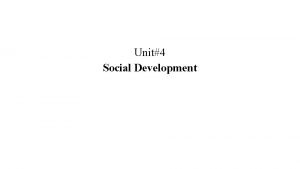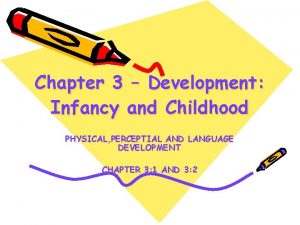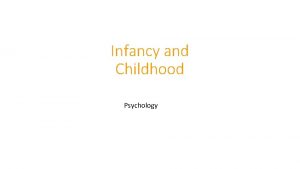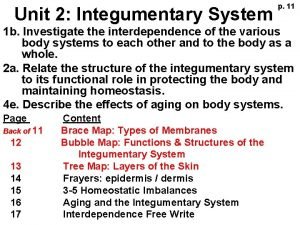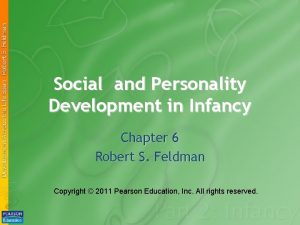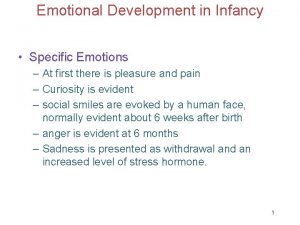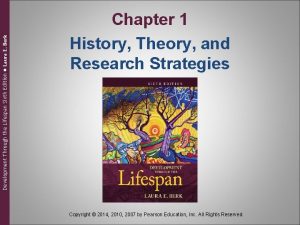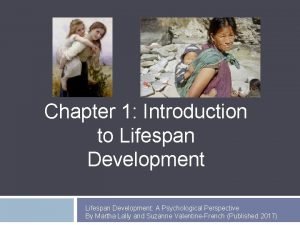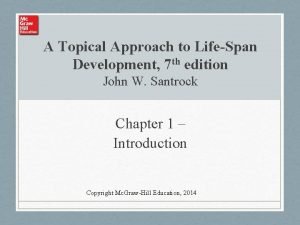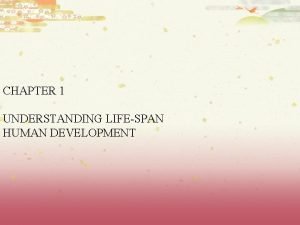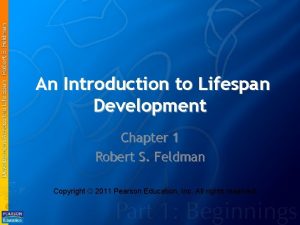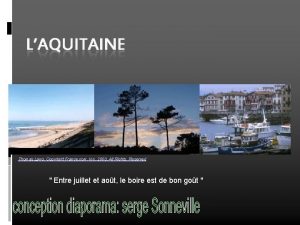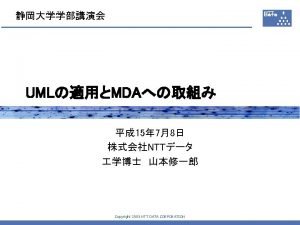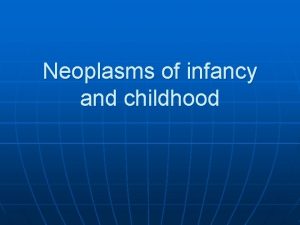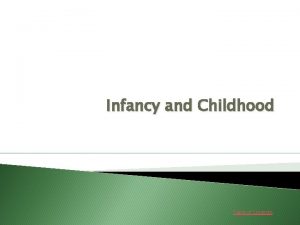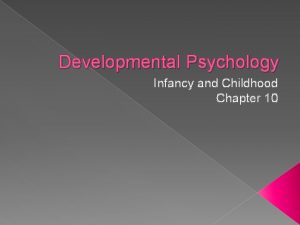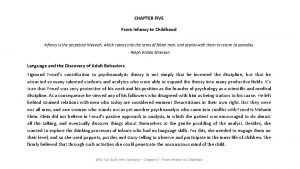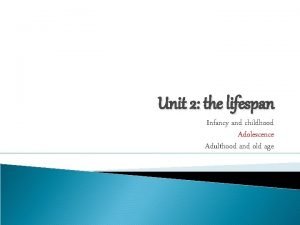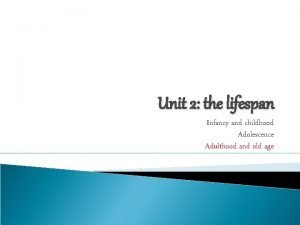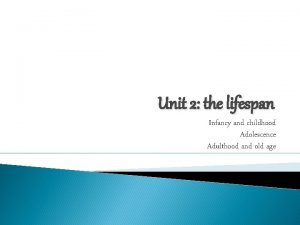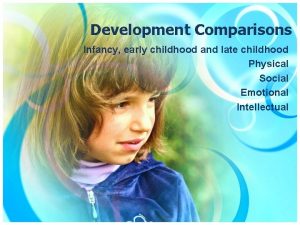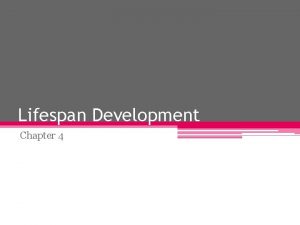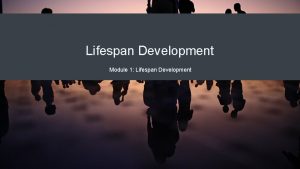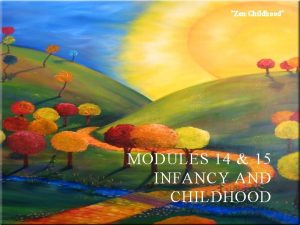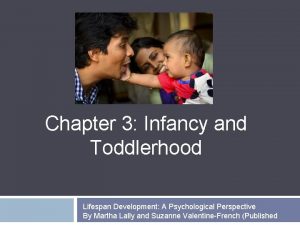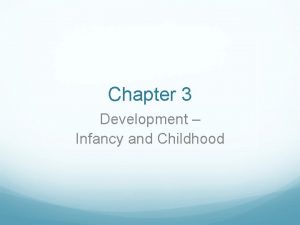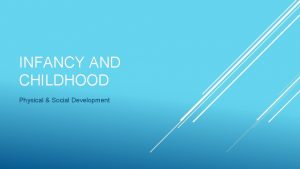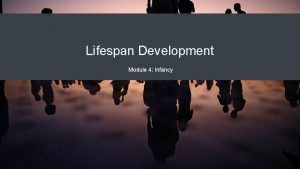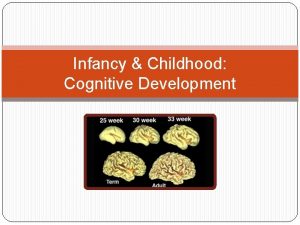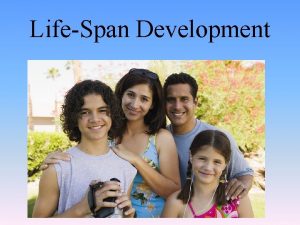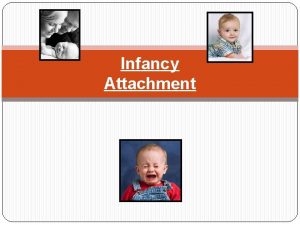Lifespan Development Infancy and Childhood Copyright 2003 All



































- Slides: 35

Lifespan Development Infancy and Childhood Copyright 2003. All rights reserved. 1

Developmental Psychology “Examines the kinds of questions that parents ask about their offspring and that all of us ask about ourselves. ” “Explores the biological, cognitive, and social aspects of development across the lifespan, from conception through infancy, childhood, adolescence, adulthood, and old age. ” --Kassin (Psychology, 4 th Ed. ) 2

Three Critical Questions in Development Psychology… 1. How much of development is influenced by genetics and how much is influenced by the environment? Nature versus Nurture debate! 3

Nature versus Nurture Argument Nature We are born with innate skills, abilities, and perceptions. Maturation: developmental changes brought about by genetic signals • Genes send signals reproductive changes • Blueprint that guides our physical and emotional development (crawl-walk-run / coo-babble-talk) 4

Reference: Robert S. Feldman, Understanding Psychology, 5 th Ed. 5

Cont… Nurture We are a clean slate—tabula rasa—at birth and the environment we live in determines who and what we become. 6

Cont… Interactionist Perspective Both nature and nurture play equal roles in our development. 7

Researching Nature vs. Nurture Determining the relative influence of nature and nurture Study of identical twins, including twins separated at birth. 8

Three Critical Questions in Developmental Psychology… 2. Is development a gradual continuum or is it a sequence of separate stages? It Depends… 9

Cont. Researchers who emphasize experience believe it is a continuous process. 10

Cont. Researchers who emphasize biological maturation see it as a predetermined set of stages/steps. 11

Three Critical Questions in Development Psychology… 3. Do our traits persist throughout our lives or do we change as we age? AGAIN…It Depends… 12

Cont. Some psychologists researchers (Humanists and Gerontologists especially) view human development as a life-long process. Others believe that basic temperament/personality develops early and remains constant throughout our lifetime (Freud, for instance). 13

Researching Stability and Change… Cross-Sectional Research Compare groups at one time Get information quickly Less expensive (compared to longitudinal work) Disadvantage: Cohort effect Longitudinal Research Follow individuals for a long period of time Eliminates cohort effect Disadvantage: Expensive, attrition, takes a long time to see results. 14

Infant & Childhood Development 15

Physical and Motor Development Physical Development during the first 2 years is phenomenal! We do not experience such a spurt of development at any other time in our lives. • By age 2, brain is 75% adult size and weight • By age 5, brain is 90% adult size and weight We are born with a finite number of brain cells! The human nervous system (brain, spinal cord, neural networks) is only beginning to form. These connections enable us to walk, talk, and remember. 16

Cont. Learning at this stage is an interaction between experience and nervous system development— each helps the other. 17

Cont. Sensory and perceptual development NEWBORNS Can distinguish between different odors, tastes, and they have a well developed sense of pain! 18

Cont. NEWBORNS Vision • Newborns: 20/200 -600 • By 6 months: 20/100 • By 2 yrs: almost 20/20 Sound • Hear sounds: last few months in the womb 19

Language Development The Pre-Linguistic Stage: Nonverbal (facial expressions, body gestures, eye contact) Crying (hunger, pain, anger) Cooing (2 months – aah, ooh, eee) Babbling (6 months – can produce almost all human sounds) Linguistic Stage: 1 year – sound related to meaning One word utterances (e. g. , mama, dada, etc. ) Between 1 and 2, string words (e. g. , want candy) NOTE: Language becomes increasingly sophisticated in later stages (not covered here). 20

Cont. NEWBORNS Love and Need Tactile Stimulation! Mark Rosenzweig Study Touch Therapy • Infant mortality rates in the 3 rd world, & during war. 21

Cont. Rosenzweig Study (1984) Differences in rats’ brain size as a result of non -communal vs. communal environment. Group 2 Group 1 22

Cont. Rosenzweig Finding… Group 1: developed a thinner layer of the cortex (a layer of gray matter over the brain), and smaller nerve cell bodies. 23

Cont. Touch Therapy Premature babies who receive Touch Therapy gain weight and grow faster than their counterparts. 24

Social-Emotional Development Attachment: Harry Harlow Showed that infants bond by attachment and NOT nourishment as previously thought. 25

Cont. Levels of attachment between infant and caregiver… Secure Attachment: Infants explore their environment more readily. Look to caregiver for support, but tries out a lot on their own. Insecure Attachment: Infants more fearful of their environment, will not seek it out as much. More clingy. 26

Cont. Does secure attachment mean more sociable behaviors later? …Maybe One long-term study followed securely and insecurely attached infants until about the 3 rd grade. “Securely attached” infants later showed higher selfesteem, performed better in school, and were more social with peers and teachers. 27

Cont. : Parenting Styles Authoritarian: Value is placed on obedience - (“Because I said so”!) Permissive-Indifferent: Provide little in terms of attention, interest or emotional support - (“Do what you want. ”) Permissive-Indulgent: Very involved, but child is in charge - Tantrums rule! Authoritative: Foster responsibility while setting limits. (“You can buy this toy today, but that means you will not buy one the next time. ”) 28

Cont. How strong is attachment anyway? Harry Harlow’s “Monster Mother. ” Child abuse and neglect findings. 29

Cont. 30

Jean Piaget (1896 -1980): Cognitive Development Theory Was the first to demonstrate that the intellect of a child is fundamentally different from that of an adult. 31

Some Basics! Schema: A way of looking at the world, a mind set. Schema’s help organize past experiences and provide a framework or blueprint for understanding future experience. Assimilation: Responding to new situations in the same manner we have responded to other similar situations. We assimilate, and incorporate new experiences into our existing schema’s. Accommodation: When we adjust the schema’s to fit the particulars or individuality of new experiences. 32

Cont. “What we know is not always reality but simply our construction of it. ” --Piaget 33

Piaget’s Stages of Cognitive Development… 1. 2. 3. 4. Sensorimotor Stage: birth - 2 years Preoperational Stage: 2 - 6 years Concrete Operational Stage: 7 - 12 years Formal Operational Stage: 12 - adulthood 34

Kohlberg’s Stages of Moral Reasoning “The way people think about and try to solve moral dilemmas. ” Preconventional Level Conventional Level Postconventional Level 35
 Early middle childhood
Early middle childhood Social development in infancy and childhood
Social development in infancy and childhood Module 47 infancy and childhood cognitive development
Module 47 infancy and childhood cognitive development Internally programmed growth of a child
Internally programmed growth of a child Rovee-collier
Rovee-collier Module 47 infancy and childhood cognitive development
Module 47 infancy and childhood cognitive development Infancy and childhood psychology
Infancy and childhood psychology Psychology chapter 10 infancy and childhood
Psychology chapter 10 infancy and childhood Chapter 10 infancy and childhood
Chapter 10 infancy and childhood Chapter 10 infancy and childhood review worksheet answers
Chapter 10 infancy and childhood review worksheet answers Lesson quiz 3-2 infancy and childhood
Lesson quiz 3-2 infancy and childhood Infancy childhood adolescence adulthood old age
Infancy childhood adolescence adulthood old age Late childhood
Late childhood What is intellectual in health and social care
What is intellectual in health and social care Chapter 5 cognitive development in infancy and toddlerhood
Chapter 5 cognitive development in infancy and toddlerhood Guidance counselling and lifespan development
Guidance counselling and lifespan development Socioemotional development in infancy
Socioemotional development in infancy Infancy psychosocial development
Infancy psychosocial development The stage of growth
The stage of growth Personality development in infancy
Personality development in infancy Infant personality development
Infant personality development New emotions that appear toward the second year
New emotions that appear toward the second year Development through the lifespan 6th edition
Development through the lifespan 6th edition Lifespan development a psychological perspective
Lifespan development a psychological perspective Openstax
Openstax Development takes place gradually
Development takes place gradually A topical approach to lifespan development
A topical approach to lifespan development Lifespan development third edition
Lifespan development third edition Lifespan development third edition
Lifespan development third edition Exploring lifespan development chapter 1
Exploring lifespan development chapter 1 Exploring lifespan development chapter 1
Exploring lifespan development chapter 1 Copyright 2003
Copyright 2003 Copyright 2003 pearson education inc
Copyright 2003 pearson education inc Copyrightfrance
Copyrightfrance Copyright 2003
Copyright 2003 Name three line segments
Name three line segments

